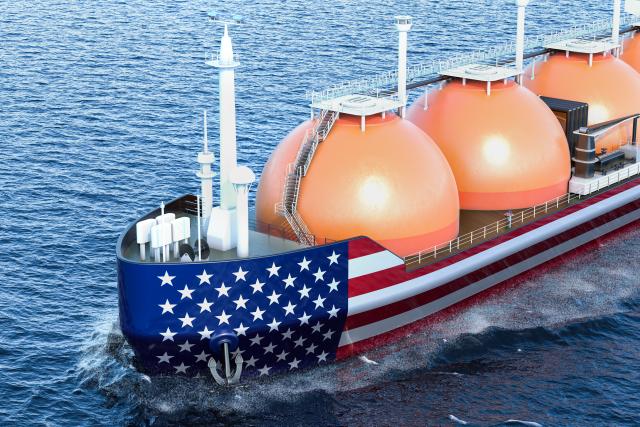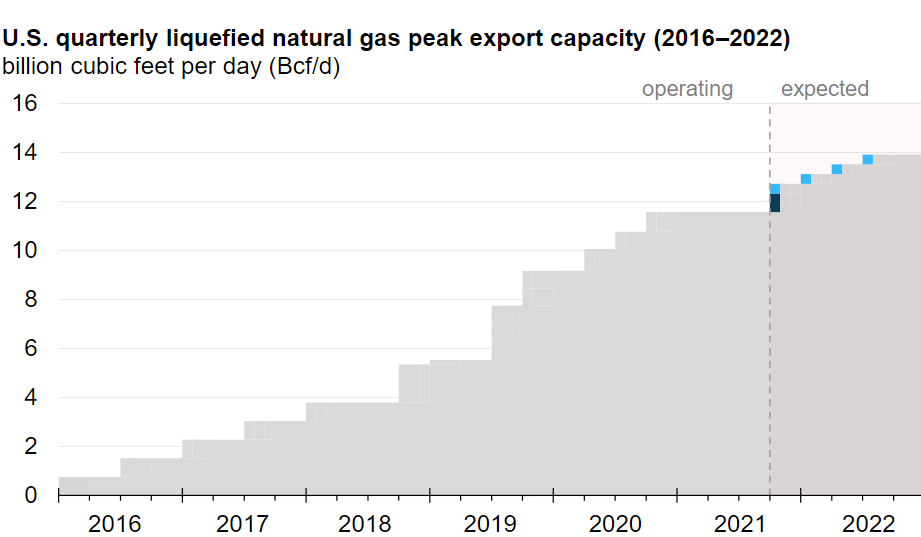
As of November 2021, the EIA estimated that U.S. LNG nominal liquefaction capacity was 9.5 Bcf/d and peak capacity was 11.6 Bcf/d. (Source: Shutterstock.com)
Despite Biden administration's efforts to combat LNG exports, more U.S. LNG export capacity is on the way by end of next year, making it the largest in the world, according to a new report by U.S. Energy Information Administration (EIA).
LNG export capacity has grown rapidly since the Lower 48 states first began exporting LNG in February 2016. Last year, U.S. became the world’s third-largest LNG exporter behind Australia and Qatar.
Once the new LNG liquefaction units, called trains, at Sabine Pass and Calcasieu Pass in Louisiana come online by the end of 2022, the EIA forecasts U.S. to have largest LNG export capacity in the world.
Train 6 at the Sabine Pass LNG export facility—which began producing LNG in late November— will add up to 0.76 Bcf/d of peak export capacity. The first export cargo from this train is expected to be shipped before the end of this year.
Calcasieu Pass LNG has 18 liquefaction trains with a combined peak capacity of 1.6 Bcf/d. The first LNG production from this new export facility is expected before the end of this year. All liquefaction trains are expected to be operational by the end of 2022.

Source: U.S. Energy Information Administration, database of U.S. LNG export facilities
RELATED: US Shale Gas Could Become ‘Biggest Green Initiative on Planet,’ EQT CEO Says
Peak LNG production capacity is the amount of LNG produced under optimal operating conditions, including modifications to production processes that increase operational efficiency.
The U.S. Federal Energy Regulatory Commission (FERC) in October 2021 approved requests to increase authorized LNG production at the Sabine Pass and Corpus Christi LNG terminals by a combined 0.7 Bcf/d. The terminals will achieve these increases by optimizing operations, including production uprates and modifications to maintenance, EIA said in its report.
The nameplate, or nominal, capacity of a liquefaction facility specifies the amount of LNG produced in a calendar year under normal operating conditions, based on the engineering design of a facility.
As of November 2021, the EIA estimated that U.S. LNG nominal liquefaction capacity was 9.5 Bcf/d and peak capacity was 11.6 Bcf/d, which includes uprates to LNG production capacity at Sabine Pass and Corpus Christi.
However, by the end of 2022, U.S. nominal capacity is expected to increase to 11.4 Bcf/d, and peak capacity will increase to 13.9 Bcf/d, exceeding capacities of the two largest LNG exporters—Australia, which has an estimated peak LNG production capacity of 11.4 Bcf/d and Qatar, which has a peak capacity of 10.4 Bcf/d. In 2024, when construction on Golden Pass LNG—the eighth U.S. LNG export facility—is completed and the facility begins operations, U.S. LNG peak export capacity will further increase to an estimated 16.3 Bcf/d, according to the Energy Department.
Recommended Reading
E&P Highlights: July 10, 2024
2024-07-10 - Here’s a roundup of the latest E&P headlines including TotalEnergies exiting South Africa to focus on opportunities in Namibia.
OPEC Gets Updated Plans From Iraq, Kazakhstan on Overproduction Compensation
2024-08-22 - OPEC and other producers including Russia, known as OPEC+, have implemented a series of output cuts since late 2022 to support the market.
Breakthroughs in the Energy Industry’s Contact Sport, Geophysics
2024-09-05 - At the 2024 IMAGE Conference, Shell’s Bill Langin showcased how industry advances in seismic technology has unlocked key areas in the Gulf of Mexico.
IOCs See Opportunity in Offshore Mexico, Despite Potential for Policy Changes
2024-08-14 - Five IOCs with offshore experience and capital—Eni, Harbour, Talos, Wintershall Dea and Woodside—continue to pursue promising opportunities offshore Mexico despite the country’s energy sovereignty push in favor of state-owned entities Pemex and CFE.
EOG Resources Wildcatting Pearsall in Western Eagle Ford Stepout
2024-07-17 - EOG Resources spud the well June 25 in Burns Ranch with rights to the Pearsall well about 4,000 ft below the Eagle Ford, according to myriad sources.
Comments
Add new comment
This conversation is moderated according to Hart Energy community rules. Please read the rules before joining the discussion. If you’re experiencing any technical problems, please contact our customer care team.




